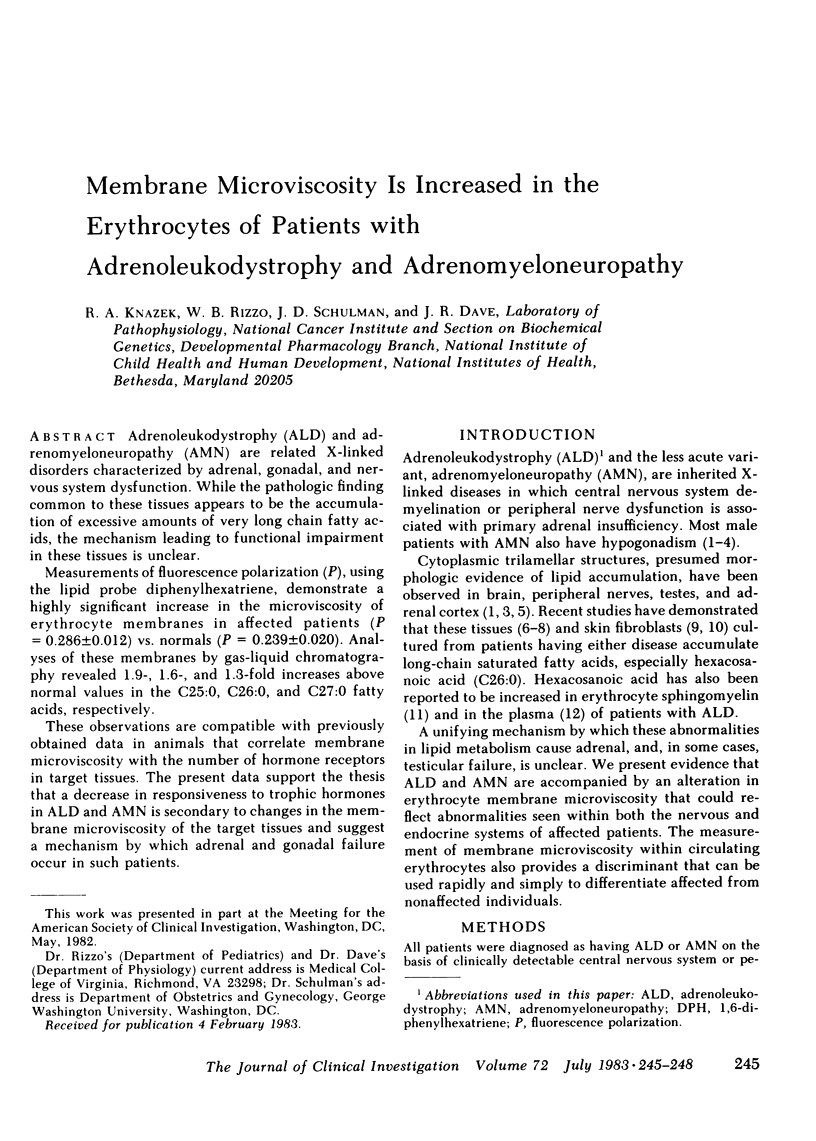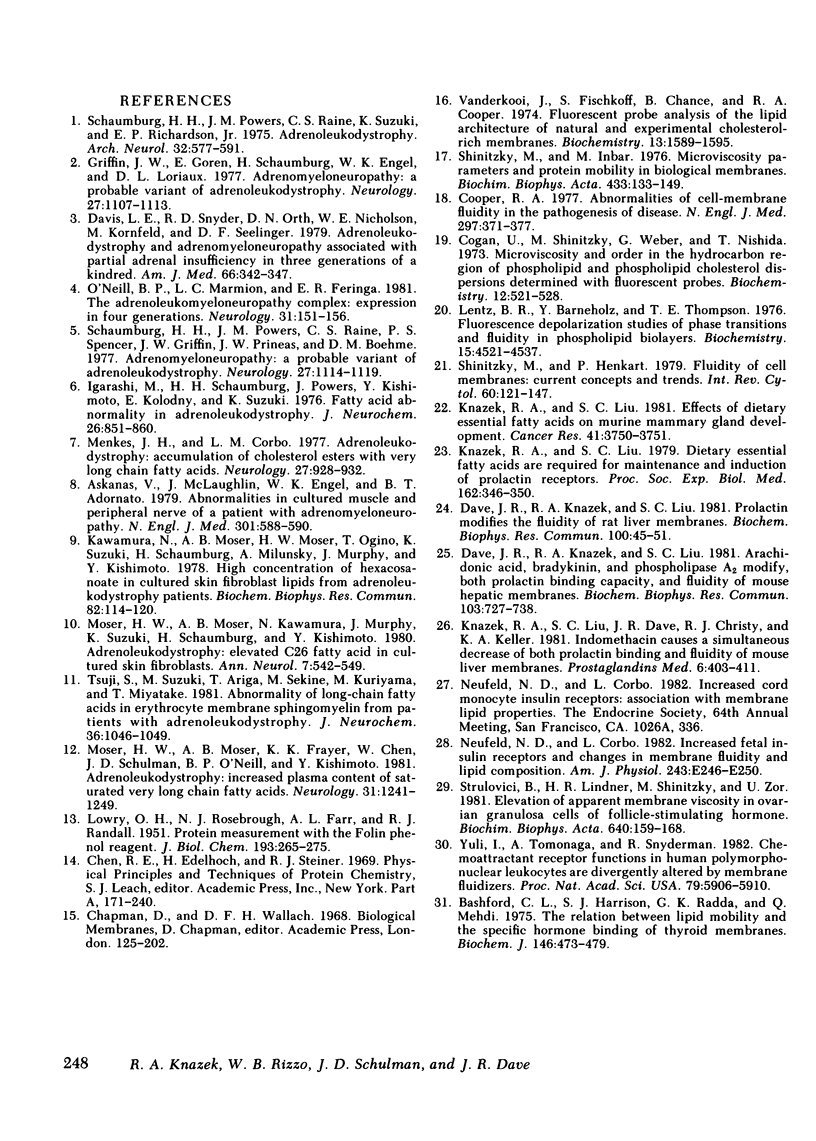Abstract
Adrenoleukodystrophy (ALD) and adrenomyeloneuropathy (AMN) are related X-linked disorders characterized by adrenal, gonadal, and nervous system dysfunction. While the pathologic finding common to these tissues appears to be the accumulation of excessive amounts of very long chain fatty acids, the mechanism leading to functional impairment in these tissues is unclear. Measurements of fluorescence polarization (P), using the lipid probe diphenylhexatriene, demonstrate a highly significant increase in the microviscosity of erythrocyte membranes in affected patients (P = 0.286 +/- 0.012) vs. normals (P = 0.239 +/- 0.020). Analyses of these membranes by gas-liquid chromatography revealed 1.9-, 1.6-, and 1.3-fold increases above normal values in the C25:0, C26:0, and C27:0 fatty acids, respectively. These observations are compatible with previously obtained data in animals that correlate membrane microviscosity with the number of hormone receptors in target tissues. The present data support the thesis that a decrease in responsiveness to trophic hormones in ALD and AMN is secondary to changes in the membrane microviscosity of the target tissues and suggest a mechanism by which adrenal and gonadal failure occur in such patients.
Full text
PDF



Selected References
These references are in PubMed. This may not be the complete list of references from this article.
- Askanas V., McLaughlin J., Engel W. K., Adornato B. T. Abnormalities in cultured muscle and peripheral nerve of a patient with adrenomyeloneuropathy. N Engl J Med. 1979 Sep 13;301(11):588–590. doi: 10.1056/NEJM197909133011105. [DOI] [PubMed] [Google Scholar]
- Bashford C. L., Harrison S. J., Radda G. K. The relation between lipid mobility and the specific hormone binding of thyroid membranes. Biochem J. 1975 Feb;146(2):473–479. doi: 10.1042/bj1460473. [DOI] [PMC free article] [PubMed] [Google Scholar]
- Cogan U., Shinitzky M., Weber G., Nishida T. Microviscosity and order in the hydrocarbon region of phospholipid and phospholipid-cholesterol dispersions determined with fluorescent probes. Biochemistry. 1973 Jan 30;12(3):521–528. doi: 10.1021/bi00727a026. [DOI] [PubMed] [Google Scholar]
- Cooper R. A. Abnormalities of cell-membrane fluidity in the pathogenesis of disease. N Engl J Med. 1977 Aug 18;297(7):371–377. doi: 10.1056/NEJM197708182970707. [DOI] [PubMed] [Google Scholar]
- Dave J. R., Knazek R. A., Liu S. C. Arachidonic acid, bradykinin and phospholipase A2 modify both prolactin binding capacity and fluidity of mouse hepatic membranes. Biochem Biophys Res Commun. 1981 Nov 30;103(2):727–738. doi: 10.1016/0006-291x(81)90510-6. [DOI] [PubMed] [Google Scholar]
- Dave J. R., Knazek R. A., Liu S. C. Prolactin modifies the fluidity of rat liver membranes. Biochem Biophys Res Commun. 1981 May 15;100(1):45–51. doi: 10.1016/s0006-291x(81)80060-5. [DOI] [PubMed] [Google Scholar]
- Davis L. E., Snyder R. D., Orth D. N., Nicholson W. E., Kornfeld M., Seelinger D. F. Adrenoleukodystrophy and adrenomyeloneuropathy associated with partial adrenal insufficiency in three generations of a kindred. Am J Med. 1979 Feb;66(2):342–347. doi: 10.1016/0002-9343(79)90562-x. [DOI] [PubMed] [Google Scholar]
- Griffin J. W., Goren E., Schaumburg H., Engel W. K., Loriaux L. Adrenomyeloneuropathy: a probable variant of adrenoleukodystrophy. I. Clinical and endocrinologic aspects. Neurology. 1977 Dec;27(12):1107–1113. doi: 10.1212/wnl.27.12.1107. [DOI] [PubMed] [Google Scholar]
- Igarashi M., Schaumburg H. H., Powers J., Kishmoto Y., Kolodny E., Suzuki K. Fatty acid abnormality in adrenoleukodystrophy. J Neurochem. 1976 Apr;26(4):851–860. doi: 10.1111/j.1471-4159.1976.tb04462.x. [DOI] [PubMed] [Google Scholar]
- Kawamura N., Moser A. B., Moser H. W., Ogino T., Suzuki K., Schaumburg H., Milunsky A., Murphy J., Kishimoto Y. High concentration of hexacosanoate in cultured skin fibroblast lipids from adrenoleukodystrophy patients. Biochem Biophys Res Commun. 1978 May 15;82(1):114–120. doi: 10.1016/0006-291x(78)90584-3. [DOI] [PubMed] [Google Scholar]
- Knazek R. A., Liu S. C., Dave J. R., Christy R. J., Keller J. A. Indomethacin causes a simultaneous decrease of both prolactin binding and fluidity of mouse liver membranes. Prostaglandins Med. 1981 Apr;6(4):403–411. doi: 10.1016/0161-4630(81)90072-0. [DOI] [PubMed] [Google Scholar]
- Knazek R. A., Liu S. C. Dietary essential fatty acids are required for maintenance and induction of prolactin receptors. Proc Soc Exp Biol Med. 1979 Nov;162(2):346–350. doi: 10.3181/00379727-162-40679. [DOI] [PubMed] [Google Scholar]
- Knazek R. A., Liu S. C. Effects of dietary essential fatty acids on murine mammary gland development. Cancer Res. 1981 Sep;41(9 Pt 2):3750–3751. [PubMed] [Google Scholar]
- LOWRY O. H., ROSEBROUGH N. J., FARR A. L., RANDALL R. J. Protein measurement with the Folin phenol reagent. J Biol Chem. 1951 Nov;193(1):265–275. [PubMed] [Google Scholar]
- Lentz B. R., Barenholz Y., Thompson T. E. Fluorescence depolarization studies of phase transitions and fluidity in phospholipid bilayers. 2 Two-component phosphatidylcholine liposomes. Biochemistry. 1976 Oct 5;15(20):4529–4537. doi: 10.1021/bi00665a030. [DOI] [PubMed] [Google Scholar]
- Menkes J. H., Corbo L. M. Adrenoleukodystrophy. Accumulation of cholesterol esters with very long chain fatty acids. Neurology. 1977 Oct;27(10):928–932. doi: 10.1212/wnl.27.10.928. [DOI] [PubMed] [Google Scholar]
- Moser H. W., Moser A. B., Frayer K. K., Chen W., Schulman J. D., O'Neill B. P., Kishimoto Y. Adrenoleukodystrophy: increased plasma content of saturated very long chain fatty acids. Neurology. 1981 Oct;31(10):1241–1249. doi: 10.1212/wnl.31.10.1241. [DOI] [PubMed] [Google Scholar]
- Moser H. W., Moser A. B., Kawamura N., Murphy J., Suzuki K., Schaumburg H., Kishimoto Y. Adrenoleukodystrophy: elevated C26 fatty acid in cultured skin fibroblasts. Ann Neurol. 1980 Jun;7(6):542–549. doi: 10.1002/ana.410070607. [DOI] [PubMed] [Google Scholar]
- Neufeld N. D., Corbo L. Increased fetal insulin receptors and changes in membrane fluidity and lipid composition. Am J Physiol. 1982 Sep;243(3):E246–E250. doi: 10.1152/ajpendo.1982.243.3.E246. [DOI] [PubMed] [Google Scholar]
- O'Neill B. P., Marmion L. C., Feringa E. R. The adrenoleukomyeloneuropathy complex: expression in four generations. Neurology. 1981 Feb;31(2):151–156. doi: 10.1212/wnl.31.2.151. [DOI] [PubMed] [Google Scholar]
- Schaumburg H. H., Powers J. M., Raine C. S., Spencer P. S., Griffin J. W., Prineas J. W., Boehme D. M. Adrenomyeloneuropathy: a probable variant of adrenoleukodystrophy. II. General pathologic, neuropathologic, and biochemical aspects. Neurology. 1977 Dec;27(12):1114–1119. doi: 10.1212/wnl.27.12.1114. [DOI] [PubMed] [Google Scholar]
- Schaumburg H. H., Powers J. M., Raine C. S., Suzuki K., Richardson E. P., Jr Adrenoleukodystrophy. A clinical and pathological study of 17 cases. Arch Neurol. 1975 Sep;32(9):577–591. doi: 10.1001/archneur.1975.00490510033001. [DOI] [PubMed] [Google Scholar]
- Shinitzky M., Henkart P. Fluidity of cell membranes--current concepts and trends. Int Rev Cytol. 1979;60:121–147. [PubMed] [Google Scholar]
- Shinitzky M., Inbar M. Microviscosity parameters and protein mobility in biological membranes. Biochim Biophys Acta. 1976 Apr 16;433(1):133–149. doi: 10.1016/0005-2736(76)90183-8. [DOI] [PubMed] [Google Scholar]
- Strulovici B., Lindner H. R., Shinitzky M., Zor U. Elevation of apparent membrane viscosity in ovarian granulosa cells by follicle-stimulating hormone. Biochim Biophys Acta. 1981 Jan 8;640(1):159–168. doi: 10.1016/0005-2736(81)90541-1. [DOI] [PubMed] [Google Scholar]
- Tsuji S., Suzuki M., Ariga T., Sekine M., Kuriyama M., Miyatake T. Abnormality of long-chain fatty acids in erythrocyte membrane sphingomyelin from patients with adrenoleukodystrophy. J Neurochem. 1981 Mar;36(3):1046–1049. doi: 10.1111/j.1471-4159.1981.tb01698.x. [DOI] [PubMed] [Google Scholar]
- Vanderkooi J., Fischkoff S., Chance B., Cooper R. A. Fluorescent probe analysis of the lipid architecture of natural and experimental cholesterol-rich membranes. Biochemistry. 1974 Apr 9;13(8):1589–1595. doi: 10.1021/bi00705a006. [DOI] [PubMed] [Google Scholar]
- Yuli I., Tomonaga A., Synderman R. Chemoattractant receptor functions in human polymorphonuclear leukocytes are divergently altered by membrane fluidizers. Proc Natl Acad Sci U S A. 1982 Oct;79(19):5906–5910. doi: 10.1073/pnas.79.19.5906. [DOI] [PMC free article] [PubMed] [Google Scholar]


